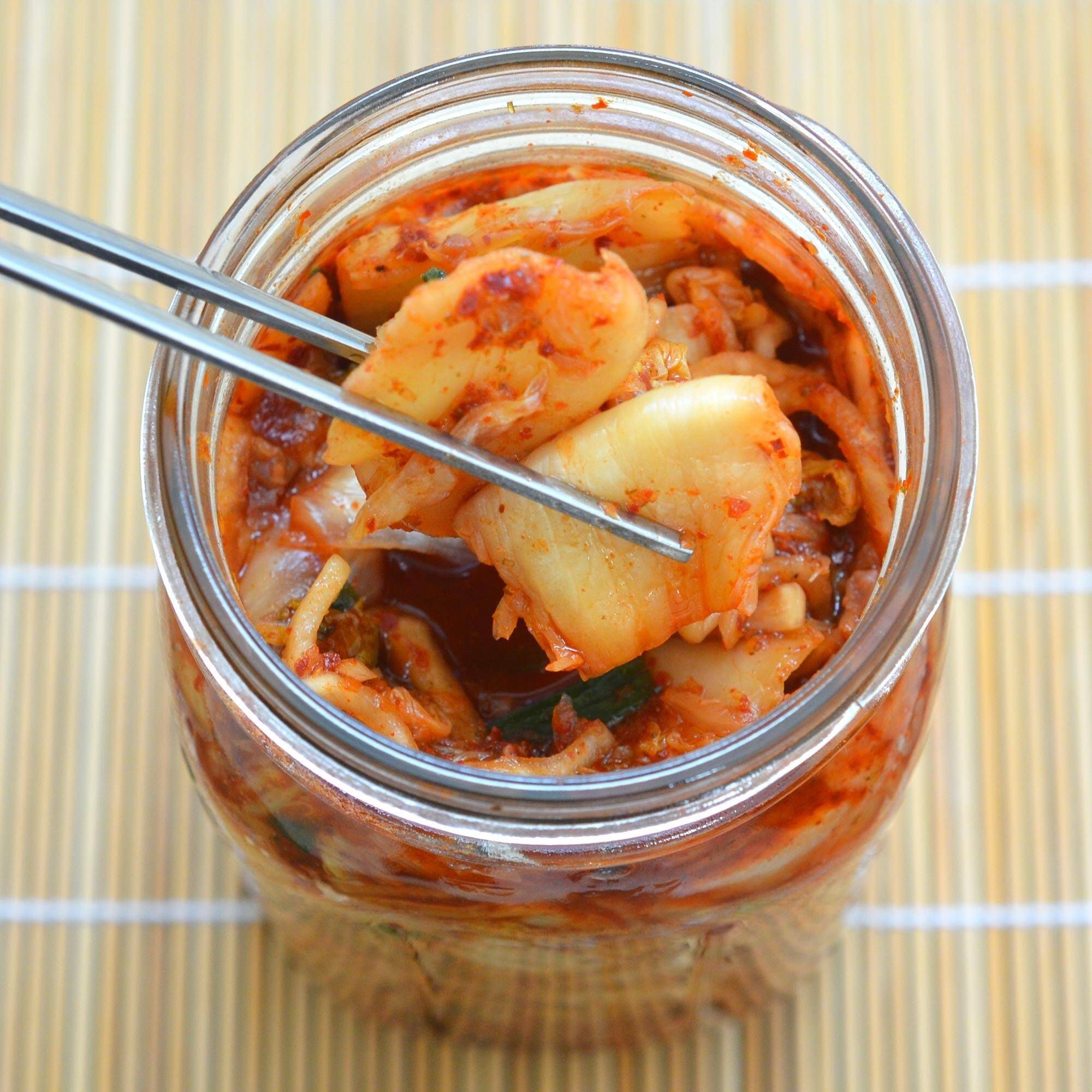What is kimchi?
Kimchi (김치) is a collective term for vegetable dishes that have been salted, seasoned, and fermented. The history of kimchi goes back to ancient times. Originated from pickled vegetables, there are now hundreds of kimchi varieties in Korea.
Over the last decade or so, Korean kimchi has gained a global recognition as a healthy probiotic food. Kimchi is a good source of useful lactic acid bacteria, has excellent anti-oxidation and anti-cancer effects, and helps prevent aging.
This kimchi recipe is made with baechu (배추), known as napa cabbage, hence the name baechu kimchi. Because the cabbage is kept intact at its head, it’s also known as pogi kimchi (포기김치). Pogi means a “head” of a vegetable.
In late fall, Korean households make this type of kimchi in large quantity for their kimjang (or gimajang, 김장), an annual kimchi making event in preparation for cold months. I grew up watching my mother make kimchi using over 100 cabbages with her friends in the neighborhood who rotated their kimjang schedules to help each other.
I usually make it with 5 – 10 heads (pogi) of cabbages at a time because we eat kimchi every day. Also, I provide regular supply to my grown-up children. Both my mother and mother-in-law did that for us for a long time, so I am gladly continuing the tradition.
In Korean homes, there can never be too much kimchi. So many Korean dishes are made with well-fermented kimchi, such as kimchi jjigae, kimchi mandu, kimchi bibim guksu, kimchi fried rice, kimchijeon, tofu kimchi, and many more.
Buying napa cabbage
For this pogi kimchi, it’s best to use a medium to large cabbage that weighs around 5 to 5-½ pounds with some light green outer leaves. When cut, a good cabbage has a nicely straight white part that’s not too thick as well as bright yellow inner leaves.
Salt for making kimchi
Korean coarse sea salt (cheonilyeom, 천일염) is the best to salt the vegetables to make kimchi. It’s natural salt with a coarse texture that’s minimally processed. Commonly referred to as gulgeun-sogeum (굵은소금), meaning coarse or thick salt, this salt tastes good without bitterness, so it helps develop flavors in fermented foods.
When we first came to America, Korean sea salt wasn’t available, so we used American table salt to salt cabbages. Be sure to use less (about ¼ less than the amount called for in the recipe) if using fine salt.
Kimchi seasonings
The taste of kimchi varies widely, depending on the quality, type and ratio of the seasoning ingredients. Each Korean household has its own recipes, often driven by the regional flavors of their hometown. I find myself making it differently each time.
Good quality gochugaru makes a big difference in kimchi. In addition to gochugaru (고추가루, Korean red chili pepper flakes), garlic and ginger, kimchi recipes typically call for various jeotgal (젓갈, salted seafood) for the distinct pungency and depth of flavors and to aid the fermentation process. Saeujeot (새우젓, salted shrimp) and myulchiaekjeot (멸치액젓, fish sauce made with anchovies) are the most common ones.
Sometimes, I also use fresh shrimp which is my mother’s secret ingredient for adding extra freshness to the kimchi flavor. If you can’t find saeujeot in your area, consider using some raw shrimp instead.
If you want to make vegan kimchi, skip shrimps and swap fish sauce with soup soy sauce (국간장). Or simply head over to my post on how to make vegan kimchi.
How to make kimchi
To help you start making kimchi at home, I came up with this recipe using one napa cabbage. Start with one cabbage, and then move to 2 or 3 by doubling or tripling the recipe.
Making kimchi usually starts with salting the main vegetable. For this pogi kimchi, you need to cut the whole cabbage in half lengthwise, and then into quarters. If you’re using 2 small cabbages, cutting in half should be enough.
You then need to thoroughly bathe each cabbage half/quarter in the salt water one at a time. Using the other half cup of salt, generously sprinkle salt over the thick white part of each leaf. This process makes sure the white parts get evenly salted,
Meanwhile, make a kimchi paste by mixing all the seasoning ingredients, and then cut the radish into thin matchsticks and mix well with the paste. The rest is easy, rub a little bit of the radish mix over each cabbage leaf, mainly the white part.
How long does kimchi last?
Although you can start eating your kimchi any time, it needs about two weeks in the fridge to fully develop its flavors. Your kimchi will continue to age in your refrigerator and will be delicious for a couple of months, when the healthy bacteria count is the highest. The kimchi will last much longer than that. It will turn very sour over time, and sour kimchi can be used in many delicious dishes!



